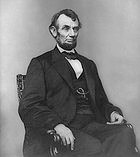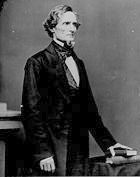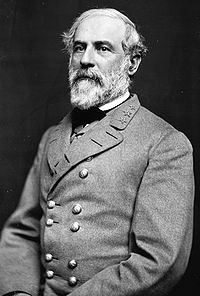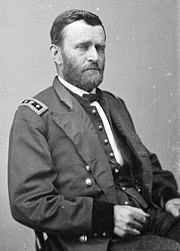|
What Caused the Civil War?
Causes of the American Civil War
What Caused the Civil War?
| U.S. President Abraham Lincoln |

|
| President Abraham Lincoln |
Regarding what caused the Civil War, the President of the United States -- as commander-in-chief
and chief executive -- declared that the sole cause of the Civil War was secession. Lincoln chose war to suppress what he deemed a rebellion in the Southern states. If the South embraced and
espoused slavery and if the South stated that the institution, alone, justified war, it was ultimately the President
of the United States, possessing absolute responsibility and duty as chief
executive for the nation, who, to the contrary, declared war on the South because of secession. As President, Lincoln
declared that the South was guilty only of rebellion, and, without the consent of Congress and contrary to
pleas from the Supreme Court, Lincoln raised an army and subsequently invaded the Southern states. Moreover, the
decision to declare war or to suppress a rebellion, and to state what caused the Civil War, was proclaimed by President
Abraham Lincoln himself; and he stated his position for war clearly.
Prior to April 15, 1861, seven Southern states, South Carolina, Georgia, Alabama, Florida, Mississippi, Louisiana and Texas, had seceded from the Union. On April 15, 1861, Lincoln stated in his Call For Troops that the only cause of the Civil War was secession in the Southern states,
and that troops were being called upon in order to "suppress the rebellion" and force the states back into the Union.
Just 2 days after Lincoln's Call for Troops to raise an army and invade the South, Virginia seceded (April 17), followed by Arkansas, North Carolina and Tennessee. Kentucky, meanwhile, refused to recruit a single soldier for Lincoln's "wicked cause," and Maryland, a free state, was invaded by U.S. troops and placed under martial law, while Delaware, though of divided loyalty, did not attempt it. In Missouri, on October 31, 1861, a pro-CSA remnant of the General Assembly met and passed an ordinance
of secession.
Lincoln, moreover, never stated publicly or in any document that abolishing the
institution of slavery was why he called upon the troops, or to free the slaves was the cause of the Civil War. The Southern
states had seceded, and Lincoln was now determined to suppress it. According to the president, secession was the cause of
the Civil War.
The Five Civilized Tribes even aligned themselves with the Confederacy, and the Cherokee Nation in its formal
declaration to unite with the Southern states leveled, among many, the following blistering accusations against Lincoln and
the Union: “But in the Northern States the Cherokee people saw with alarm a violated Constitution, all civil liberty
put in peril, and all the rules of civilized warfare and the dictates of common humanity and decency unhesitatingly disregarded.
In States which still adhered to the Union a military despotism has displaced the civil power and the laws became silent amid
arms. Free speech and almost free thought became a crime. The right to the writ of habeas corpus, guaranteed by the Constitution, disappeared at the nod of a Secretary of State or a general of the lowest grade.
The mandate of the Chief Justice of the Supreme Court was set at naught by the military power, and this outrage on common right approved
by a President sworn to support the Constitution. …Lincoln sent armies into Southern States to aid in subjugating a
people struggling for freedom, to burn, to plunder, and to commit the basest of outrages on women; while the heels
of armed tyranny trod upon the necks of Maryland and Missouri, and men of the highest character and position were incarcerated
upon suspicion and without process of law in jails, in forts, and in prison-ships, and even women were imprisoned by the arbitrary
order of a President and Cabinet ministers; while the press ceased to be free.”
| Confederate President Jefferson Davis |

|
| President Jefferson Davis |
There were many reasons for a Civil War to happen in America, and political
issues and disagreements began soon after the American Revolution ended in 1782. Between the years 1800 and 1860, arguments
between the North and South grew more intense. One of the main quarrels was about taxes paid on goods brought into this country
from foreign countries. This tax was called a tariff. Southerners felt these tariffs were unfair and aimed toward them because they imported a wider variety of goods than most
Northern people. Taxes were also placed on many Southern goods that were shipped to foreign countries, an expense that was
not always applied to Northern goods of equal value. An awkward economic structure allowed states and private transportation
companies to do this, which also affected Southern banks that found themselves paying higher interest rates on loans made
with banks in the North. The situation grew worse after several "panics", including one in 1857 that affected more Northern
banks than Southern. Southern financiers found themselves burdened with high payments just to save Northern banks that had
suffered financial losses through poor investment.
In the years before the Civil War the political power in the Federal
government, centered in Washington, D.C., was changing. Northern and mid-western states were becoming more and more powerful
as the populations increased. Southern states lost political power because the population did not increase as rapidly. As
one portion of the nation grew larger than another, people began to talk of the nation as sections. This topic was referred
to as sectionalism. Just as the thirteen original colonies fought for their independence almost 100 years earlier, the Southern
states felt a growing need for freedom from the central Federal authority in Washington. Southerners believed that state laws
carried more weight than Federal laws, and they should abide by the state regulations first. This issue was known as States' Rights and it became a hot topic in congress.
Another quarrel between the North and South and perhaps the most emotional
one, was over the issue of slavery. America was an agricultural nation and crops such as cotton were in demand around the
world. Cotton was a plant that grew well in the southern climate, but it was a difficult plant to gather and process. Labor
in the form of slaves was used on large plantations to plant and harvest cotton as well as sugar, rice, and other cash crops.
The invention of the Cotton Gin by Eli Whitney made cotton more profitable for southern growers. Before this invention, it
took one person all day to process two pounds of cotton by hand, a slow and inefficient method. Whitney's Cotton Gin machine
could process that much within a half hour. Whitney's invention revolutionized the cotton industry and Southern planters saw
their profits soar as more and more of them relied on cotton as their main cash crop. Slaves were a central part of that industry.
Slavery had been a part of life in America since the early colonial
period and became more acceptable in the South than the North. Southern planters relied on slaves to run larger farms or plantations
and make them profitable. Many slaves were also used to provide labor for the various household chores that needed to be done.
This did not sit well with many northerners who felt that slavery was uncivilized and should be abolished. They were called
abolitionists and thought that owning slaves was wrong for any reason. They loudly disagreed with the United States Constitution
and the South's laws and beliefs concerning slavery. Slavery, however, had been introduced, embraced, and protected by
the U.S. Constitution many years before the Civil War. Slavery eventually became an important part of the Southern way
of life and was protected not only by state laws, but Federal law as well. The Constitution, moreover, guaranteed the
right to own property and protected everyone against the seizure of property. A slave was viewed as property by the United
States and was important to the economics of the Southern cotton industry. So, the people of the Southern states did not appreciate
Northern people, especially the abolitionists, telling them that slave ownership was a great wrong. This created a great amount
of debate, mistrust, confusing and misunderstanding because the North, or United States, introduced slavery to America. Now
the United States had changed its mind and no longer approved of slavery, but, on the other hand, the U.S. Constitution
still permitted slavery. The South was confused as to why the Constitution allowed slavery, but the United States was now
condemning it.
| Confederate General Robert E. Lee |

|
| Confederate General Robert E. Lee |
As the nation grew in size, so did the opportunities for expansion westward.
Many felt that slavery should be allowed in the new territories such as Kansas and Missouri, while others were set against
it. This led to "Bleeding Kansas", a bitter war that pitted neighbor against neighbor. In 1859, a fanatic and radical abolitionist from Kansas named John Brown raided the Federal armory at Harpers Ferry, Virginia, in the hopes of supplying weapons to an army of slaves that would revolt
against their southern masters. A number of people were taken hostage and several murdered, among them the mayor of Harpers
Ferry. Brown was cornered with several of his followers in a fire engine house, first by Virginia militia and then by Federal
troops sent to arrest him and his raiders. These troops, commanded by Colonel Robert E. Lee, stormed the building and captured
Brown and several of his men. Brown was tried for his crimes, found guilty of many crimes including murder, and was hanged
in Charlestown. Though John Brown's raid had failed, it fueled the passions of some northern abolitionists who made him a martyr. It was reported that bells tolled in sympathy to John Brown in some northern cities on the day he
was executed. This inflamed passions in the South where southern leaders used the incident as another reminder how little
the South's interests were represented in Federal law, labeled as sympathetic to runaways and anti-slavery.
The debate became very bitter. Southern politicians outwardly charged
that their voices were not being heard in congress. Some Southern states wanted to secede, or break away from the United States of America and govern themselves. Emotions reached a fever pitch when Abraham Lincoln
was elected President of the United States in 1860. He was a member of the Republican Party and vowed to keep the country
united and the new western territories free from slavery, but Lincoln vowed to allow slavery to continue in the South
and in Washington, D.C. Many Southerners, who were Democrats, were afraid that Lincoln was not sympathetic to their way
of life and would not treat them fairly. The growing strength of the Republican Party, viewed by many as the party friendly
to abolitionists and northern businessmen, and the election of the party's candidate was the last straw. Southern governors
and political leaders called for state referendums to consider articles of secession. South Carolina was the first state to
officially secede from the United States soon after the election and they were followed by six other Southern states. These
states joined together and formed a new nation which they named the Confederate States of America. They elected Jefferson
Davis, a Democratic senator and champion of states rights from Mississippi, as the first president.
On April 12, 1861, the Confederate States of America attacked Fort Sumter, South Carolina. The fort sits
at the entrance to Charleston Harbor and was manned by Union troops who flew the United States flag. The bombardment lasted
many hours and the fort was heavily damaged, though no one was killed or injured. Major Robert Anderson surrendered the fort
and its garrison to the Confederate commanders. Now that open conflict had started, President Lincoln responded with a call
for volunteers from states still loyal to the Union, to enlist and put down this treacherous act of rebellion. Alarmed that
Lincoln would do this, four more Southern states seceded and joined the Confederacy. The war that President Lincoln had tried
to avoid began anyway. War talk was on everyone's lips and sharp divisions took place, even among families and neighbors.
However, the principal or main cause of the Civil
War was Secession itself.
| Union General U.S. Grant |

|
| Union General U.S. Grant |
At first, no one believed the war would last very long. Some people said
it would take only a few months and the fellows who volunteered to fight would come home heroes within a few weeks. No one
realized how determined the South was to be independent, nor did the South realize how determined the North was to end the
rebellion. Armies had to be raised in the North and the South, and every state was asked to raise regiments of volunteers
to be sent for service in the field. Many young men chose to enlist and volunteered for military service. In the South, men
readily went to war to protect their homes and save the Southern way of life. Most did not believe that the government in
Washington was looking out for the South's interests and they were better off as a new nation where the states would make
up their own laws. Many were happy to be called rebels because they thought they were fighting against a tyrant like their
forefathers did against the British during the American Revolution. Northern men volunteered to put down the rebellion of
southern states and bind the nation back together. Some felt that the Southerners had rebelled without good cause and had
to be taught a lesson. Some also felt that slavery was an evil. So, 'after' the war started, Lincoln used the war as justification
to abolish slavery. No one knew how terrible war really was and how hard life as a soldier could be. They did not have
television or radio to communicate the terrible things that could happen. Politicians did not communicate either, which was
one of the main reasons for the war and misunderstandings between North and South. The armies were raised and marched off
to war. It was only after many battles and many lives were lost that the American people realized how horrible war really
was. The soldiers communicated with their families and loved ones and told them of the hardships they endured and terrible
scenes they had witnessed.
Who was to blame for the Civil War? Some blamed the South because
it had left the United States, while others blamed President Lincoln because he had invaded the South with large
armies. The fighting of the American Civil War would last four long years at a cost of 620,000 killed. In the end, however, the
Northern states prevailed- our country remained united, and the Federal government was changed forever. Even today, the
causes of the war, who started the war, and even the name of the war itself are subjects of debate.
Recommended Viewing: The Civil War - A Film by
Ken Burns. Review: The Civil War - A Film by Ken Burns is the most successful public-television miniseries in
American history. The 11-hour Civil War didn't just captivate a nation, reteaching to us our history in narrative
terms; it actually also invented a new film language taken from its creator. When people describe documentaries using the
"Ken Burns approach," its style is understood: voice-over narrators reading letters and documents dramatically and stating
the writer's name at their conclusion, fresh live footage of places juxtaposed with still images (photographs, paintings,
maps, prints), anecdotal interviews, and romantic musical scores taken from the era he depicts. Continued below...
The Civil War uses all of these devices to evoke atmosphere and resurrect an event that many knew
only from stale history books. While Burns is a historian, a researcher, and a documentarian, he's above all a gifted storyteller,
and it's his narrative powers that give this chronicle its beauty, overwhelming emotion, and devastating horror. Using the
words of old letters, eloquently read by a variety of celebrities, the stories of historians like Shelby Foote and rare, stained
photos, Burns allows us not only to relearn and finally understand our history, but also to feel and experience it. "Hailed
as a film masterpiece and landmark in historical storytelling." "[S]hould be a requirement for every
student."
Related Reading:
Recommended Reading: The History Buff's Guide to the Civil War
(400 pages). Description: Exploring the Civil War can be fascinating, but with so many battles, leaders, issues, and more
than 50,000 books on these subjects, the task can also be overwhelming. Was Gettysburg the most important battle? Were Abraham
Lincoln and Jefferson Davis so different from each other? What caused the Civil War? (Just like a divorce, there are
two sides to the story.) How accurate is re-enacting? Who were the worst commanding generals? Thomas R. Flagel uses annotated
lists organized under more than thirty headings to see through the powder smoke and straighten Sherman’s neckties, ranking
and clarifying the best, the worst, the largest, and the most lethal aspects of the conflict. Continued below...
Major sections are fashioned around the following topics:
• Antebellum: Investigates the critical years before the war, in particular
the growing crises, extremists, and slavery.
• Politics: Contrasts the respective presidents and constitutions
of the Union and Confederacy, the most prominent politicians, and the most volatile issues of the times.
• Military Life: Offers insights into the world of the common soldiers,
how they fought, what they ate, how they were organized, what they saw, how they lived, and how they died.
• The Home Front: Looks at the fastest growing field in Civil War
research, including immigration, societal changes, hardships and shortages, dissent, and violence far from the firing lines.
• In Retrospect: Ranks the heroes and heroines, greatest victories
and failures, firsts and worsts.
• Pursuing the War: Summarizes Civil War study today, including films,
battlefield sites, books, genealogy, re-enactments, restoration, preservation, and other ventures.
From the antebellum years to Appomattox and beyond, The History Buff’s
Guide to the Civil War is a quick and compelling guide to one of the most complex and critical eras in American history.
Recommended Reading: Eyewitness to the Civil War (National
Geographic) (Hardcover) (416 pages) (November 21, 2006). Review: This grand history is majestic in both scope and scale: an
informed overview for general-interest readers and a superb resource for serious Civil War buffs, this extraordinary, gloriously
illustrated volume is sure to become one of the fundamental books in any Civil War library. Its features include a dramatic
narrative packed with eyewitness accounts and hundreds of rare photographs, artifacts, and period illustrations. Evocative
sidebars, detailed maps, and timelines add to the reference-ready quality of the text. Continued below...
From John Brown's raid to
Reconstruction, Eyewitness to the Civil War presents a clear, comprehensive discussion that addresses every military, political,
and social aspect of this crucial period. In-depth descriptions of campaigns and battles in all theaters of war are accompanied
by a thorough evaluation of the nonmilitary elements of the struggle between North and South. In their own words, commanders
and common soldiers in both armies tell of life on the battlefield and behind the lines,
while letters from wives, mothers, and sisters provide a portrait of the home front. More
than 375 historical photos, portraits, and artifacts—many never before published—evoke the era's flavor; and detailed
maps of terrain and troop movements make it easy to follow the strategies and tactics of Union and Confederate generals
as they fought through four harsh years of war. Photoessays on topics ranging from the everyday lives of soldiers to the dramatic
escapades of the cavalry lend a breathtaking you-are-there feeling, and an inclusive appendix adds even more detail to what
is already a magnificently meticulous history. If you purchase one book this year, this is it. RATED 5 STARS by americancivilwarhistory.org. About the Author: Neil Kagan, editor, heads Kagan & Associates Inc., a firm
specializing in innovative illustrated books, and is the guiding spirit behind numerous book series including Voices of the
Civil War and Our American Century. Recently, he edited Great Battles of the Civil War, Great Photographs of the Civil War,
and National Geographic Concise History of the World. He lives in Falls Church,
Virginia. Stephen
G. Hyslop is a writer and editor of books on American and world history, including National Geographic Almanac of World History
(with Patricia Daniels). He served as editor for the history series Time Frame, What Life Was Like, and American Indians.
He is a contributing writer for History Channel Magazine.
Courtesy National Park Service

|

